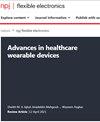Miniaturized all-in-one microneedle device for point of care light therapy
IF 12.3
1区 材料科学
Q1 ENGINEERING, ELECTRICAL & ELECTRONIC
引用次数: 0
Abstract
Light therapies have been applied to millions of patients for treating many kinds of diseases, especially superficial ones. Currently, mainstream light therapies utilize the combined effects of photosensitizers and light to either remove disordered tissue or promote the growth of healthy tissue. Adverse effects of light therapy, including metabolic burden caused by circulatory photosensitizer and skin damage induced by high irradiance light, are yet to be addressed. This study provides a Miniaturized all-in-one Light therapy Device (MiLD). All components required for light therapy, including dual-function microneedles, LED array, control circuit, and battery are integrated together to form a miniaturized portable device with 2 cm in length, 1.7 cm in width, 1.2 cm in height, and 3.6 g in weight. The all-in-one design and patch-to-cure operation of MiLD enables the successful demonstration of point-of-care light therapy. Satisfactory therapeutic effects have been verified in mice on both types of light therapy. Meanwhile, transdermally co-delivering both photosensitizer and light in situ fully avoids photosensitizer accumulation in blood and remarkably reduces the irradiance of light, therefore significantly alleviating metabolic burden and light-induced skin damage. Overall, the MiLD lays the technical foundation of point-of-care light therapy with its miniaturized all-in-one design, simple patch-to-cure operation, satisfactory therapeutic effects, and minimum adverse effects.

用于护理点光疗的微型一体化微针设备
光疗法已被数百万患者用于治疗多种疾病,尤其是浅表性疾病。目前,主流的光疗法是利用光敏剂和光的联合作用来清除紊乱的组织或促进健康组织的生长。光疗的不良反应,包括循环光敏剂引起的代谢负担和高辐照度光引起的皮肤损伤,仍有待解决。这项研究提供了一种微型一体化光疗设备(MiLD)。光疗所需的所有组件,包括双功能微针、LED 阵列、控制电路和电池都集成在一起,形成了一个长 2 厘米、宽 1.7 厘米、高 1.2 厘米、重 3.6 克的微型便携式装置。MiLD 的一体化设计和 "贴片到治疗 "的操作使其能够成功展示护理点光疗法。在小鼠身上验证了这两种光疗的满意疗效。同时,原位经皮同时给药光敏剂和光,充分避免了光敏剂在血液中的蓄积,并显著降低了光的辐照度,从而大大减轻了代谢负担和光引起的皮肤损伤。总之,MiLD 以其微型化的一体化设计、从贴片到治疗的简单操作、令人满意的治疗效果和最小的不良反应,为护理点光治疗奠定了技术基础。
本文章由计算机程序翻译,如有差异,请以英文原文为准。
求助全文
约1分钟内获得全文
求助全文
来源期刊

npj Flexible Electronics
Multiple-
CiteScore
17.10
自引率
4.80%
发文量
91
审稿时长
6 weeks
期刊介绍:
npj Flexible Electronics is an online-only and open access journal, which publishes high-quality papers related to flexible electronic systems, including plastic electronics and emerging materials, new device design and fabrication technologies, and applications.
 求助内容:
求助内容: 应助结果提醒方式:
应助结果提醒方式:


